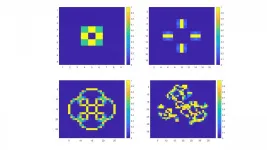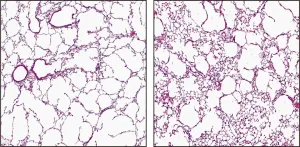(Press-News.org) By José Tadeu Arantes | Agência FAPESP – Gluten is a protein complex found in cereals such as wheat, rye and barley. It is responsible for the elastic texture of dough so that loaves and rolls can be baked into different shapes while remaining flexible and crusty. It also lengthens the shelf life of bread at room temperature, when associated with preservatives.
Gluten intolerance, however, has become a global epidemic, and gluten-free products are increasingly popular. The problem is that most of those available on the market are far from corresponding to consumers’ expectations in terms of appearance, aroma, flavor and durability. A research line focusing on ways to enhance gluten-free products is being pursued in Brazil by nutritionist Vanessa Dias Capriles, a professor at the Federal University of São Paulo (UNIFESP) in Santos.
Her work is supported by FAPESP via Young Investigator and Multiuser Equipment grants. The research has resulted so far in 14 articles in scientific journals. The latest is published in Foods.
“Three conditions are currently recognized as grounds for prescribing a gluten-free diet: celiac disease, wheat allergy, and non-celiac gluten sensitivity. Celiac disease is a chronic dysfunction of genetic origin that affects 1.4% of the world population and can lead to multisystem disorders, with severe complications when left untreated. Wheat allergy is an immune reaction to the proteins in wheat. Non-celiac gluten sensitivity is a condition that can be caused by gluten or other components of wheat such as rapidly fermentable carbohydrates. Unlike celiac disease, it isn’t an autoimmune condition, and its symptoms, albeit often similar, aren’t associated with such severe complications,” Capriles told Agência FAPESP.
To meet demand from people with these conditions, but also from a much larger number of consumers who, for health-related or faddish reasons, want to eliminate gluten from their diet completely or partially, the volume of gluten-free products available is growing spectacularly and they are fast becoming a global trend instead of a niche market.
“However, the development of these products is a major technological challenge,” Capriles said. “Bread made with wheat flour has been an important human food for millennia. The sense impressions it causes are deeply ingrained in people’s lifestyle. That’s why it’s important to develop enhanced versions of these products. Market research shows that consumers are dissatisfied with the appearance, aroma, variety and convenience of the products currently available.”
Besides deficient sensory quality, gluten-free bread is often nutritionally poor. “Generally speaking, it’s made with refined starch such as rice bran combined with corn, potato and cassava starch,” she said. “It contains little fiber, proteins, vitamins or minerals, and relatively large amounts of fat. It’s not enriched with micronutrients in many countries.”
The research under way at UNIFESP has three goals: improving the overall nutritional value of gluten-free products, increasing their acceptability to consumers, and seeking technologically feasible solutions.
“We’ve obtained more than 15 formulations we consider optimal, using different techniques to create and optimize these products. They contain 50%-100% gluten-free wholemeal flour, and as a result, they contain a large proportion of fiber, with more proteins, vitamins and minerals,” Capriles said. “Qualitative consumer surveys show our gluten-free wholemeal bread products achieve comparable acceptability to bread made with regular wheat flour.”
The group researched different raw materials, including wholemeal flour from cereals such as rice, sorghum and millet; pseudo-cereals such as amaranth, quinoa and buckwheat; and others such as chickpeas, dry beans and pine nuts.
To increase the fiber content, they tried using psyllium, with positive results. Psyllium is a fibrous material made from husks of the seeds of the plant Plantago ovata. Every 100 grams supply 80 grams of soluble fiber. It is hygroscopic and expands to form a gelatinous mass when mixed with water. It is popular among consumers who are looking for functional foods and is often recommended to help treat constipation, diabetes and atherosclerosis.
“We succeeded in producing bread with 17% psyllium. Because it absorbs water, dough made with psyllium can be molded into many shapes, just like rolls and loaves made with conventional wheat flour,” Capriles said. “In more recent studies, we associated psyllium with chickpea flour and obtained surprisingly good results. Besides high acceptability and nutritiousness, its advantages include a low glycemic response [it does not raise blood sugar significantly] and heightened satiety in healthy people. Another very interesting point is that it maintained its acceptability even after being stored at room temperature for seven days.”
Next steps include finding partners in industry to transfer the technology to, she added, as well as moving ahead with the research and development on a collaborative basis.
The article “Psyllium improves the quality and shelf life of gluten-free bread” is at www.mdpi.com/2304-8158/10/5/954.
Study innovates in gluten-free formulations, creating more palatable and nutritious bread
Study at the Federal University of São Paulo developed a recipe combining chickpea flour and psyllium, a plant-derived soluble fiber. The product is nourishing and rated highly by consumers in qualitative surveys.
2021-07-21
ELSE PRESS RELEASES FROM THIS DATE:
Thumb-sized device quickly 'sniffs out' bad breath
2021-07-21
No one wants bad breath -- not when visiting friends and family, at a job interview, and especially not on a first date. Smelly breath can make things awkward, but it also is a natural warning sign, indicating that serious dental issues are occurring. Now, researchers reporting in ACS Nano have constructed a portable, thumb-sized device that diagnoses bad breath by quickly "sniffing" exhalations for the gas that makes it stinky -- hydrogen sulfide.
Because most people can't smell their own breath, they need to ask someone else, which can be embarrassing and awkward. Some devices measure small amounts of stinky hydrogen sulfide, but they require exhaled air to be collected and tested on expensive instruments in a lab, which is not feasible ...
Toward one drug to treat all coronaviruses
2021-07-21
Safe and effective vaccines offer hope for an end to the COVID-19 pandemic. However, the possible emergence of vaccine-resistant SARS-CoV-2 variants, as well as novel coronaviruses, make finding treatments that work against all coronaviruses as important as ever. Now, researchers reporting in ACS' Journal of Proteome Research have analyzed viral proteins across 27 coronavirus species and thousands of samples from COVID-19 patients, identifying highly conserved sequences that could make the best drug targets.
Drugs often bind inside "pockets" on proteins that hold the drug snugly, causing it to interfere with the protein's function. Scientists can identify potential drug-binding pockets from the 3D structures of viral proteins. ...
Rounding errors could make certain stopwatches pick wrong race winners
2021-07-21
WASHINGTON, July 21, 2021 -- As the Summer Olympics draw near, the world will shift its focus to photo finishes and races determined by mere fractions of a second. Obtaining such split-second measurements relies on faultlessly rounding a raw time recorded by a stopwatch or electronic timing system to a submitted time.
Researchers at the University of Surrey found certain stopwatches commit rounding errors when converting raw times to final submitted times. In American Journal of Physics, by AIP Publishing, David Faux and Janet Godolphin outline a series of computer simulations based on procedures for converting raw race times for display.
Faux was inspired when he encountered ...
Nanostructures enable record high-harmonic generation
2021-07-21
ITHACA, N.Y. - Cornell researchers have developed nanostructures that enable record-breaking conversion of laser pulses into high-harmonic generation, paving the way for new scientific tools for high-resolution imaging and studying physical processes that occur at the scale of an attosecond - one quintillionth of a second.
High-harmonic generation has long been used to merge photons from a pulsing laser into one, ultrashort photon with much higher energy, producing extreme ultraviolet light and X-rays used for a variety of scientific purposes. Traditionally, gases have been used as sources of harmonics, but a research team led by Gennady Shvets, professor of applied and engineering physics ...
Researchers reverse emphysema in mice by injecting blood vessel wall cells
2021-07-21
Researchers at Weill Cornell Medicine and NewYork-Presbyterian in New York have discovered that injecting mice with pulmonary endothelial cells--the cells that line the walls of blood vessels in the lung--can reverse the symptoms of emphysema. The study, which will be published July 21 in the Journal of Experimental Medicine (JEM), may lead to new treatments for chronic obstructive pulmonary disease (COPD), an inflammatory lung disease associated with smoking that is thought to be the third leading cause of death worldwide.
Emphysema is one of the characteristic features ...
Real-time stress detection devices could help fight alcohol relapses
2021-07-21
Wearable devices can detect people's stress, according to new Washington State University research, opening potential new interventions for people with addictions.
In a paper published today, July 21, in the END ...
Who eats the invaders?
2021-07-21
A landmark scientific study involving marine biologists from Greece, Turkey, Cyprus, Libya, Italy, Tunisia, the UK, the US and even Malta, documenting instances where native Mediterranean species have preyed upon two highly invasive marine fish - the Pacific red lionfish and the silver-cheeked toadfish - has just been published. Prof. Alan Deidun, coordinator of the Spot the Alien Fish citizen science campaign and resident academic within the Department of Geosciences of the Faculty of Science, is a co-author of such an extensive study.
The Pacific red lionfish (Pterois miles) and the silver-cheeked toadfish (Lagocephalus sceleratus) are amongst the most invasive of non-indigenous fish species to enter the Mediterranean in recent years, posing both ecological and socio-economic hazards. ...
SARS-CoV-2 variant B.1.617 gives the immune system a hard time
2021-07-21
SARS-CoV-2 still poses major challenges to mankind. The frequent emergence of mutant forms makes the threat posed by the virus difficult to predict. The SARS-CoV-2 variant B.1.617 circulated in India and gave rise to the Delta variant, B.1.617.2, which is now becoming dominant in many countries. Infection researchers from the German Primate Center (DPZ) - Leibniz Institute for Primate Research in Göttingen have investigated the B.1.617 variant in detail. In cell culture studies, they found that this variant can infect certain lung and intestinal cell lines more efficiently than the original ...
Many ICU staff have experienced mental health conditions in COVID-19 pandemic
2021-07-21
A high proportion of staff working in intensive care units during the COVID-19 pandemic have experienced mental health conditions, according to a new study.
In a study of 515 healthcare staff working in intensive care units (ICUs) across seven countries, the researchers found that on average 48 percent of participants showed signs of mental health conditions - depression, insomnia and post-traumatic stress disorder (PTSD). Their mental health was assessed using a detailed questionnaire and a clinical scoring system.
The team also found a 40 per cent increase in the conditions for those who spent more than six hours in personal protective equipment (PPE) over ...
Using ultra-low temperatures to understand high-temperature superconductivity
2021-07-21
At low temperatures, certain materials lose their electrical resistance and conduct electricity without any loss - this phenomenon of superconductivity has been known since 1911, but it is still not fully understood. And that is a pity, because finding a material that would still have superconducting properties even at high temperatures would probably trigger a technological revolution.
A discovery made at TU Wien (Vienna) could be an important step in this direction: A team of solid-state physicists studied an unusual material - a so-called "strange metal" made of ytterbium, rhodium and silicon. Strange metals show an unusual relationship between electrical resistance and temperature. ...
LAST 30 PRESS RELEASES:
AI replaces humans in identifying causes of fuel cell malfunctions
Pitfalls of FDA-approved germline cancer predisposition tests
A rising trend of 'murderous verbs' in movies over 50 years
Brain structure differences are associated with early use of substances among adolescents
Pain coping skills training for patients receiving hemodialysis
Trends of violence in movies during the past half century
Major depressive disorder and driving behavior among older adults
John Howington, MD, MBA, FCCP, to become the 87th President of the American College of Chest Physicians
Preclinical study finds surges in estrogen promote binge drinking in females
Coming AI economy will sell your decisions before you take them, researchers warn
NASA’s Parker Solar Probe makes history with closest pass to Sun
Are we ready for the ethical challenges of AI and robots?
Nanotechnology: Light enables an "impossibile" molecular fit
Estimated vaccine effectiveness for pediatric patients with severe influenza
Changes to the US preventive services task force screening guidelines and incidence of breast cancer
Urgent action needed to protect the Parma wallaby
Societal inequality linked to reduced brain health in aging and dementia
Singles differ in personality traits and life satisfaction compared to partnered people
President Biden signs bipartisan HEARTS Act into law
Advanced DNA storage: Cheng Zhang and Long Qian’s team introduce epi-bit method in Nature
New hope for male infertility: PKU researchers discover key mechanism in Klinefelter syndrome
Room-temperature non-volatile optical manipulation of polar order in a charge density wave
Coupled decline in ocean pH and carbonate saturation during the Palaeocene–Eocene Thermal Maximum
Unlocking the Future of Superconductors in non-van-der Waals 2D Polymers
Starlight to sight: Breakthrough in short-wave infrared detection
Land use changes and China’s carbon sequestration potential
PKU scientists reveals phenological divergence between plants and animals under climate change
Aerobic exercise and weight loss in adults
Persistent short sleep duration from pregnancy to 2 to 7 years after delivery and metabolic health
Kidney function decline after COVID-19 infection
[Press-News.org] Study innovates in gluten-free formulations, creating more palatable and nutritious breadStudy at the Federal University of São Paulo developed a recipe combining chickpea flour and psyllium, a plant-derived soluble fiber. The product is nourishing and rated highly by consumers in qualitative surveys.





